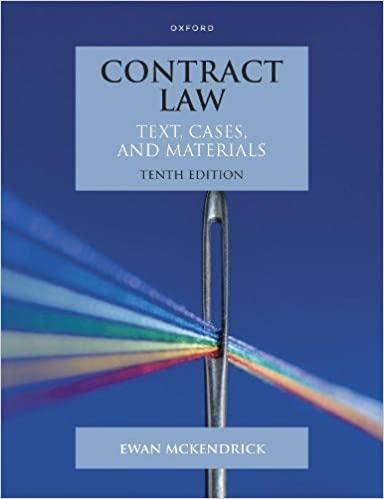Question
Question William Berry was the sole shareholder of Phenix, Inc., which operated a popular nightclub of the same name in Columbus, Georgia. Berry maintained corporate
Question
William Berry was the sole shareholder of Phenix, Inc., which operated a popular nightclub of
the same name in Columbus, Georgia. Berry maintained corporate checking accounts, but he
paid his employees, suppliers, and entertainers in cash out of the club's proceeds. He owned the property on which the club was located and rented it to the club, but made the mortgage
payments out of the club's proceeds. Berry often paid corporate expenses out of his personal
funds. At 11:45 p.m. on July 31, 1996, eighteen-year-old Daniel Hansford, who was already
intoxicated, entered the Phenix Club. A city ordinance prohibited individuals under the age of
twenty-one from entering nightclubs, but Phenix employees did not check Hansford's
identification. Hansford drank more alcohol and was visibly intoxicated when he left the club at
3:00 a.m. with a beer in her hand. Shortly afterward, Hansford was killed when he lost control of his car and struck a tree. Jim Williams, Hansford's stepfather, filed a suit in a Georgia state court. Discuss.
In this case I have William Berry who is a sole Shareholder of Phenix Inc. William Berry may be held liable if we can prove proper corporate formalities were not being followed. William Berry mixed his personal and business funds using the entity Phenix Inc. as a "shield liability". This brings us to the concept of Piercing the Corporate veil. I believe Mr. Berry is using his corporate entity to evade his suit. The evidence of abuse of the corporate entity is where Mr. Berry disregarded the separateness of legal entities he mixed his corporate funds and personal funds. In this case there was no adoption or ratification formed so William Berry will be held liable.
Question 2
K told R that K had an opportunity to do kitchen remodeling work for Lowe's Company in Santa Clara and asked R to become his job superintendent and estimator in this venture. K said that he had about $10,000.00 to invest in the venture and that, if R would superintend and estimate the jobs, K would share the profits with R on a 50-50 basis. K did not ask R to agree to share any loss that might result and R did not offer to share any such loss. The subject of a possible loss was not discussed in the inception of this venture. R accepted K's proposal and commenced work for the venture. R's only contribution was his own labor. K provided all of the venture's financing through the credit of Siding Company, although at times R purchased materials for the jobs in his own name or on his account for which he was reimbursed.
In this case K and R were not in a legal partnership. This is because they did not share in losses or risks. Generally, partnership law also applies to joint ventures.In this case all participants are personally liable for its debt, and joint ventures owe each other a fiduciary duty. The key factor in this case would be the sharing of profits. This would make a general partnership even though K is providing all the financing acting as a promoter.
Step by Step Solution
There are 3 Steps involved in it
Step: 1

Get Instant Access to Expert-Tailored Solutions
See step-by-step solutions with expert insights and AI powered tools for academic success
Step: 2

Step: 3

Ace Your Homework with AI
Get the answers you need in no time with our AI-driven, step-by-step assistance
Get Started


